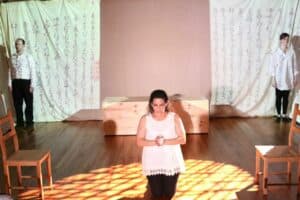Shredded Storytelling Undermines THE PILLOW BOOK at Cohesion/Strand
Posted on BroadwayWorld.com June 27, 2015
One of the frequent perks of being a theater reviewer is receiving a .pdf of the script. It’s a great crutch; you don’t need to scribble down piquant bits of dialogue. But in the case of the show I saw last night, The Pillow Book by Anna Moench, the script is not so much a perk as a vital lifeline. Seeing the play in performance without reading the script – allof the script, including a so-called Actor’s Guide at the back – you will never be able to make enough sense of it.
The Pillow Book takes off from the current vogue of non-consecutive story-telling; everyone wants to emulate the mystification of Pulp Fiction, with its sudden reveals of not only what will happen, but of what did happen. And recently there has been an additional vogue, which I call Cubistic story-telling, in which the characters and their lives turn out multiple ways, without an authoritative single story line. The recent Broadway musical If/Then was a mild example of dramatic Cubism (one in which the central character’s life is told from the perspective of a pair of unexpectedly consequential choices she makes, and we see the life she would have had either way as a result). The approaches can also be combined, as in another recent Broadway production, Constellations by Nick Payne, where the couple at its center meet and get together, or don’t get together, and come apart, or don’t come apart, and she dies or she doesn’t die of cancer – and in addition to all these slightly different stories there are periodic breaks from chronological order. These works make the viewer struggle to follow the conflicting and shuffled storylines, but never leave the viewer in the dust.
The dust, however, is where The Pillow Book will leave you, and, as the Actor’s Guide reveals, utterly gratuitously. For it emerges from the Actor’s Guide that, under a chaotic surface, there are three internally coherent, if externally inconsistent stories being told, stories that would be much more absorbing if we could piece them together in real time. There are three characters (John, Deb and Deborah), whose names do not change, even though the John of one story line has nothing to do with the Johns of the two other story lines, and Deborah is “an abstraction of Deb, not grounded in anything but Deb” – whatever that may mean, and the women frequently double up as incidental characters (an exterminator, a member of the ski patrol, etc.) still without losing their names. And the scenes that limn just one of the three storylines for instance are, in chronological order: 15, 16, 4, 2, 7, 14, 18, 28, and 31. You will therefore be left wondering why John, who seems to want so badly to have a child with his wife Deb, suddenly seems to be trying to explain to a daughter about the loss of his wife. Turns out that while delivering this explanation, John is enacting the role of the parent of Deborah, who is not a character in the story of the John who wants the child with Deb, who is not a character in Deborah’s story. But you won’t be able to work that out on your own. And that’s just an example of the incoherence.
And what a waste that incoherence is! Anna Moench writes beautifully; she is really, really good at crafting a memorable scene and characters about whom one could be persuaded to care. But all that goes for naught when one can’t tell where on earth one is. Director Jonas David Grey advises in his program notes to “Allow yourself to take in each image of this ‘collage’ before trying to piece it all together. And trust the relationships, for they tell the story.” Sorry, that kind of advice might work with some works (I think the aforementioned Constellations would be a case in point) but with this play those two precepts are simply in conflict. The superimposed and non-chronological storytelling causes the stories to shred each other, and in consequence, the relationships, which can be glimpsed, can never be comprehended thoroughly enough to become trustworthy.
The more is the pity, because the acting and direction are also so good. Michele Massa as Deb, Joseph Coracle as John, and Rebecca Ellis as Deborah convey wit, anger, regret, fear, longing, and passion as the need arises, without a false step. Together with their director, they seem to have mined from the text everything Moench has buried there to be excavated.
And what, briefly, is that? I think it is a note of regret over things not achieved or seen, but it is a regret tempered in certain ways. John in his role as a tourist visiting the Serengeti wants to see elephants, and is guaranteed by his guide Deborah that he will see them, but she shows him only dung beetles and termites. Later, however, after he temporarily and accidentally blinds her with Mace and causes her to break her hand, they seem to be setting off for the elephants again. And Deborah seems to be getting over a sexual assault the trauma of which explains some of her erratic behavior. John in his role as Deb’s husband, wrestles with her reluctance to conceive a child with him, though their “parenthood” of a dog seems to fill some of that need. John, in a completely different role as Deb’s husband, is unable to make the marriage work, runs away to go skiing, and has an accident that shatters his femur, but at least help is on the way, and he is likely to be patched up.
I’m not the only critic who has lamented the damage wrought by the play’s incoherence, which was a common complaint when The Pillow Book was staged at New York’s 59E59 in 2011. For all that, however, I’m glad of a chance to have seen it, and I’m glad that it was brought to Baltimore by a coalition of two fringe companies, Cohesion Theatre Company (ending its first season) and The Strand Theatre Company, which focuses on works by and about women. We need companies that are willing to take on the challenging works, even if (as I think was the case here) some challenges can’t be entirely surmounted. I hope we’ll see more collaborations like these.
Copyright (c) Jack L. B. Gohn, except for production photo. Photo Credit: Shaelyn Jae Photography


 I lived in London and Vienna before coming to the United States, and grew up mainly in Ann Arbor. I was writing plays and stories as early as grade school. My undergraduate years at the University of Pennsylvania, where I first reviewed theater, for the college paper, were succeeded by graduate study at the Johns Hopkins University, where I earned a doctorate in English Literature.
I lived in London and Vienna before coming to the United States, and grew up mainly in Ann Arbor. I was writing plays and stories as early as grade school. My undergraduate years at the University of Pennsylvania, where I first reviewed theater, for the college paper, were succeeded by graduate study at the Johns Hopkins University, where I earned a doctorate in English Literature.